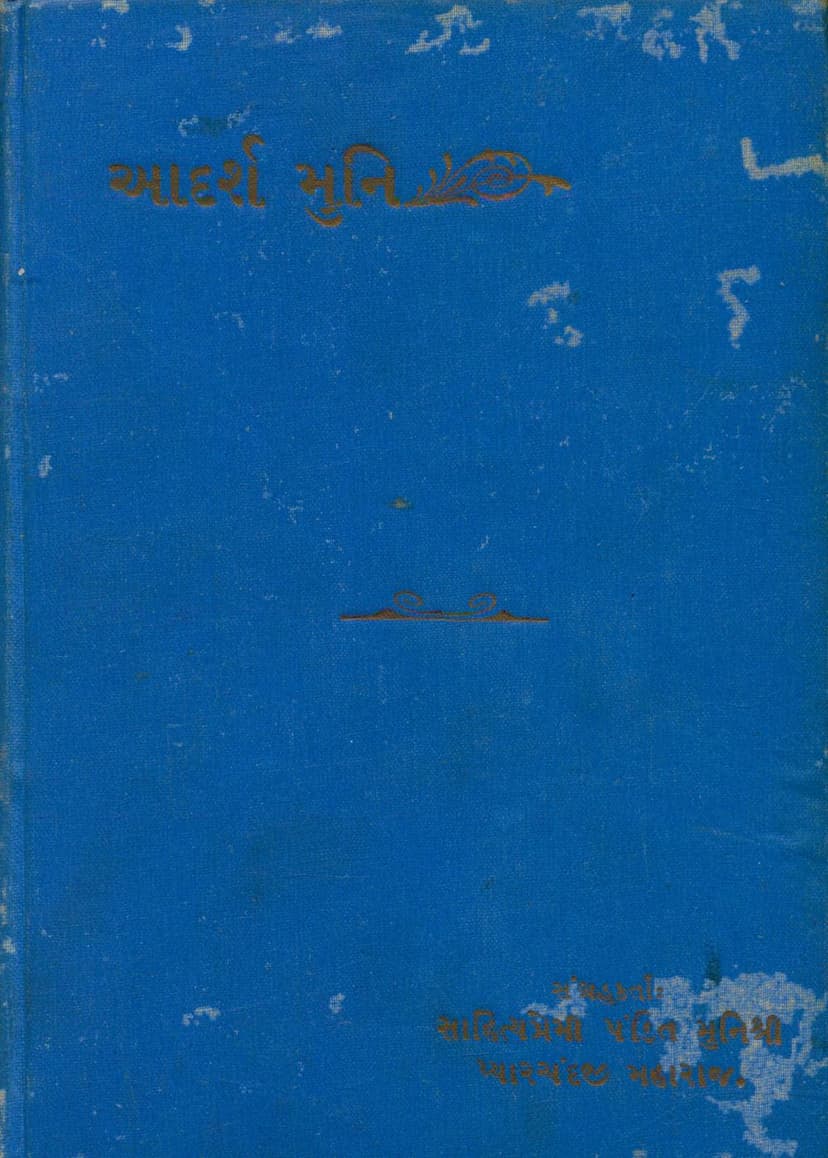Adarsh Muni
Added to library: September 1, 2025

Summary
Here's a comprehensive summary of the Jain text "Adarsh Muni," based on the provided pages:
Book Title: Adarsh Muni (Ideal Monk) Author: Pyarchand Maharaj (Compiler), Chandulal Mohanlal Modi (Translator) Publisher: Jainoday Pustak Prakashan Samiti, Ratlam Publication Date: Veer Samvat 2458 / Vikram Samvat 1988 (corresponding to 1931/1932 CE)
Overall Theme:
"Adarsh Muni" is a biographical work that chronicles the life and teachings of the revered Jain monk, Muni Chaturmalji Maharaj (also referred to as Chouthamalji, Chauthamalji, or Chaturmal). The book aims to present his life as an ideal example for spiritual seekers, highlighting his profound spiritual qualities, extensive travels, impactful preaching, and contributions to social reform and the propagation of Jain principles.
Key Aspects and Content:
-
Introduction and Testimonials:
- The book begins with prayers and auspicious verses (Mangalacharan) emphasizing the importance of ahimsa, self-control, and penance.
- It includes endorsements and opinions from prominent figures like Rai Bahadur Jugmandirlal Jaini (Chief Justice, Indore State) and Vadi Lal Motilal Shah (Ghatkopar, Mumbai). These testimonials praise the book's objective of portraying an ideal life and highlight Muni Chaturmalji's ability to popularize Jainism through public lectures, his understanding of human psychology, and his commitment to social reform even among orthodox audiences.
- Reviews from non-Jain publications like "Naya Daur," "Manorama," "Dharma Dhwaj," "Digambar Jain," and "Madhuri" are also included, acknowledging the book's educational value, inspirational content, and effective presentation of Jain principles, including its historical claims.
-
The Life of Muni Chaturmalji:
- Family Background: The book details Muni Chaturmalji's birth in Neemuch town in Vikram Samvat 1933 (1876 CE). His father was Gangaramji, and his mother was Kesarbai. His family belonged to the Oswal Jain community. The text provides brief insights into his parents and siblings.
- Early Life and Education: Despite a comfortable upbringing, his destiny was not to remain in worldly life. His early inclination towards spirituality and renunciation is evident. He received a basic education, including Hindi and some English and Urdu. He also had a natural talent for music and poetry.
- The Tragedy of Brother's Murder: A significant event in his youth was the murder of his elder brother, Kaluram, who had fallen into gambling. This incident, along with the subsequent suffering and the unwavering spiritual fortitude of his mother, played a role in shaping his spiritual path.
- Renunciation and Diksha (Initiation): At the age of 30, after receiving his mother's consent and taking inspiration from his guru, Muni Hiralalji, he embraced the ascetic life. The book details the rigorous training and discipline involved in his spiritual journey.
- Extensive Travels and Preaching: The majority of the book chronicles Muni Chaturmalji's extensive travels across India. It meticulously details his visits to numerous cities and villages, his public lectures (Vyakhyans), and the impact of his teachings on diverse audiences. The narrative highlights his ability to connect with people from all walks of life, including royalty, scholars, merchants, and common folk, regardless of their religious or social background.
- Social Reform and Impact: Muni Chaturmalji was not just a spiritual leader but also a social reformer. The text recounts instances where his sermons led to the abandonment of harmful practices like animal sacrifice, the adoption of vegetarianism, the practice of vows (vrat), and the eradication of social evils like child marriage and the sale of girls. His influence extended to inspiring many to embrace asceticism.
- Tapasya (Penance) and Austerity: The book emphasizes Muni Chaturmalji's rigorous adherence to vows and his practices of austerity, including fasting and controlled consumption, which were essential aspects of his spiritual discipline.
- Key Themes in his Teachings: His teachings focused on core Jain principles like ahimsa (non-violence), truthfulness, self-control, detachment, charity, spiritual knowledge, and the path to salvation (moksha). He stressed the importance of the soul's journey and the consequences of karma.
- Interactions with Royalty and Dignitaries: The book mentions his interactions with rulers like the Maharana of Udaipur and officials from various states, demonstrating his respect and influence across societal strata.
- Literary Contributions: While primarily known for his preaching, he also contributed to Jain literature through his poems and writings, some of which are mentioned as being published and widely read.
- Disciples and Legacy: The book lists some of his prominent disciples, highlighting how they followed his teachings and continued his spiritual mission. It emphasizes his role in guiding his followers towards a more virtuous and spiritually fulfilling life.
-
Jain Dharma and its Ancient Roots:
- The book delves into the ancient origins and principles of Jainism, asserting its antiquity and distinctness from Buddhism. It references ancient texts and scholarly opinions to establish Jainism's historical depth and philosophical foundations, particularly the concept of syadvada (a doctrine of conditional predication).
- It discusses the purity and ethical nature of Jain literature, suitable for all ages and genders.
-
Structure and Style:
- The book is structured chronologically, detailing events year by year or by significant periods in Muni Chaturmalji's life.
- The language is rich and descriptive, aiming to convey the spiritual aura and impact of his presence and teachings. The use of Sanskrit verses and their Gujarati translations adds a devotional element.
- The numerous testimonials and endorsements from respected individuals lend credibility to the narrative.
Significance:
"Adarsh Muni" serves as a comprehensive guide and inspiration for Jains and others interested in spiritual living. It showcases the exemplary life of a Jain monk who dedicated his existence to the service of humanity and the propagation of spiritual truths, leaving an indelible mark on society through his teachings, character, and reforms. The book is a testament to the enduring power of spiritual discipline, ethical conduct, and selfless service.